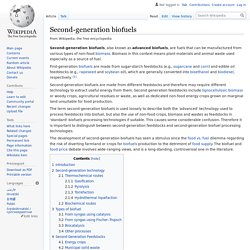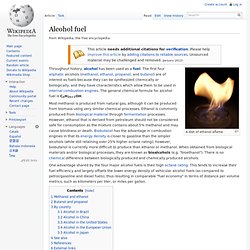

Second generation biofuels - Wikipedia, the free encyclopedia - Second-generation biofuels, also known as advanced biofuels, are fuels that can be manufactured from various types of non-food biomass.

Biomass in this context means plant materials and animal waste used especially as a source of fuel. First-generation biofuels are made from sugar-starch feedstocks (e.g., sugarcane and corn) and edible oil feedstocks (e.g., rapeseed and soybean oil), which are generally converted into bioethanol and biodiesel, respectively. [1] Second-generation biofuels are made from different feedstocks and therefore may require different technology to extract useful energy from them. Second generation feedstocks include lignocellulosic biomass or woody crops, agricultural residues or waste, as well as dedicated non-food energy crops grown on marginal land unsuitable for food production. Introduction[edit] Second-generation technology[edit] The following subsections describe the main second-generation routes currently under development.
Thermochemical routes[edit] Biofuel - Wikipedia, the free encyclopedia - (Build 201004010646. A biofuel is a fuel that contains energy from geologically recent carbon fixation.

These fuels are produced from living organisms. Examples of this carbon fixation occur in plants and microalgae. These fuels are made by a biomass conversion (biomass refers to recently living organisms, most often referring to plants or plant-derived materials). This biomass can be converted to convenient energy containing substances in three different ways: thermal conversion, chemical conversion, and biochemical conversion. This biomass conversion can result in fuel in solid, liquid, or gas form. Bioethanol is an alcohol made by fermentation, mostly from carbohydrates produced in sugar or starch crops such as corn, sugarcane, or sweet sorghum. Biodiesel can be used as a fuel for vehicles in its pure form, but it is usually used as a diesel additive to reduce levels of particulates, carbon monoxide, and hydrocarbons from diesel-powered vehicles.
Liquid fuels for transportation[edit] Biodiesel - Wikipedia, the free encyclopedia - (Build 2010040106. Bus run by biodiesel Space-filling model of methyl linoleate, or linoleic acid methyl ester, a common methyl ester produced from soybean or canola oil and methanol Space-filling model of ethyl stearate, or stearic acid ethyl ester, an ethyl ester produced from soybean or canola oil and ethanol Biodiesel refers to a vegetable oil- or animal fat-based diesel fuel consisting of long-chain alkyl (methyl, ethyl, or propyl) esters.

Biodiesel is typically made by chemically reacting lipids (e.g., vegetable oil, animal fat (tallow[1][2])) with an alcohol producing fatty acid esters. Biodiesel is meant to be used in standard diesel engines and is thus distinct from the vegetable and waste oils used to fuel converted diesel engines. The National Biodiesel Board (USA) also has a technical definition of "biodiesel" as a mono-alkyl ester.[3] Blends[edit] Biodiesel sample Applications[edit] Distribution[edit] Vehicular use and manufacturer acceptance[edit]
Alcohol fuel - Wikipedia, the free encyclopedia - (Build 2010040. A dish of ethanol aflame Throughout history, alcohol has been used as a fuel.

The first four aliphatic alcohols (methanol, ethanol, propanol, and butanol) are of interest as fuels because they can be synthesized chemically or biologically, and they have characteristics which allow them to be used in internal combustion engines. The general chemical formula for alcohol fuel is CnH2n+1OH. Most methanol is produced from natural gas, although it can be produced from biomass using very similar chemical processes. Ethanol is commonly produced from biological material through fermentation processes. One advantage shared by the four major alcohol fuels is their high octane rating. Methanol and ethanol[edit]
Biogas - Wikipedia, the free encyclopedia - (Build 2010040106463. Pipes carrying biogas (foreground), natural gas and condensate Biogas typically refers to a mixture of gases produced by the breakdown of organic matter in the absence of oxygen.

Biogas can be produced from regionally available raw materials such as recycled waste. It is a renewable energy source and in many cases exerts a very small carbon footprint. The gases methane, hydrogen, and carbon monoxide (CO) can be combusted or oxidized with oxygen. This energy release allows biogas to be used as a fuel; it can be used for any heating purpose, such as cooking. Biogas can be compressed, the same way natural gas is compressed to CNG, and used to power motor vehicles. Production[edit] Biogas production in rural Germany Biogas is practically produced as landfill gas (LFG) or digested gas. Landfill gas[edit] Landfill gas is produced by wet organic waste decomposing under anaerobic conditions in a landfill.[7][8] The methane in biogas is 20 times more potent a greenhouse gas than carbon dioxide.
Biodiesel 101 - (Build 20100401064631)